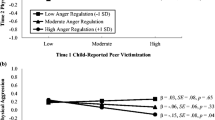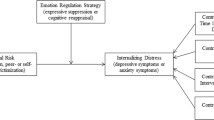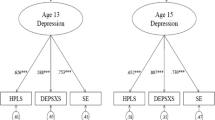Abstract
This study examined the relations of fifth-grade children’s (181 boys and girls) daily experiences of peer victimization with their daily negative emotions. Children completed daily reports of peer victimization and negative emotions (sadness, anger, embarrassment, and nervousness) on up to eight school days. The daily peer victimization checklist was best represented by five factors: physical victimization, verbal victimization, social manipulation, property attacks, and social rebuff. All five types were associated with increased negative daily emotions, and several types were independently linked to increased daily negative emotions, particularly physical victimization. Girls demonstrated greater emotional reactivity in sadness to social manipulation than did boys, and higher levels of peer rejection were linked to greater emotional reactivity to multiple types of victimization. Sex and peer rejection also interacted, such that greater rejection was a stronger indicator of emotional reactivity to victimization in boys than in girls.

Similar content being viewed by others
References
Bakker, M. P., Ormel, J., Verhulst, F. C., & Oldehinkel, A. J. (2010). Peer stressors and gender differences in adolescents’ mental health. The TRAILS study. J Adolesc Health, 46, 444–450.
Bauer, D. J., & Curran, P. J. (2005). Probing interactions in fixed and multilevel regression: inferential and graphical techniques. Multivar Behav Res, 40, 373–400.
Benenson, J. F., & Benarroch, D. (1998). Gender differences in responses to friends’ hypothetical greater success. Journal of Early Adolescence, 18, 192–208.
Blascovich, J., & Berry Mendes, W. (2000). Challenge and threat appraisals: The role of affective cues. In J. P. Forgas (Ed.), Feeling and thinking: The role of affect in social cognition. Studies in emotion and social interaction (pp. 59–82). New York: Cambridge.
Bolger, N., Davis, A., & Rafaeli, E. (2003). Dairy methods: capturing life as it is lived. Annu Rev Psychol, 54, 579–616.
Buhs, E. S., Ladd, G. W., & Herald, S. L. (2006). Peer exclusion and victimization: processes that mediate the relation between peer group rejection and children’s classroom engagement and achievement? J Educ Psychol, 98, 1–13.
Bukowski, W. M., Hoza, B., & Boivin, M. (1994). Measuring friendship quality during pre- and early adolescence: the development and psychometric properties of the friendship qualities scale. J Soc Pers Relat, 11, 471–484.
Card, N. A., & Hodges, E. V. (2008). Peer victimization among schoolchildren: correlations, causes, consequences, and considerations in assessment and intervention. Sch Psychol Q, 23, 451–461.
Card, N. A., Stucky, B. D., Sawalani, G. M., & Little, T. D. (2008). Direct and indirect aggression during childhood and adolescence: a meta-analytic review of gender differences, intercorrelations, and relations to maladjustment. Child Dev, 79, 1185–1229.
Champion, K. M., & Clay, D. L. (2007). Individual differences in responses to provocation and frequent victimization by peers. Child Psychiatry Hum Dev, 37, 205–220.
Chung, T., & Asher, S. R. (1996). Children’s goals and strategies in peer conflict situations. Merrill-Palmer Q, 42, 125–147.
Coie, J. D. (1990). Toward a theory of peer rejection. In S. R. Asher & J. D. Coie (Eds.), Peer rejection in childhood (pp. 365–398). Cambridge: Cambridge University Press.
Coie, J. D., & Dodge, K. A. (1983). Continuities and changes in children’s social status: a five-year longitudinal study. Merrill-Palmer Q, 29, 261–282.
Coie, J. D., Dodge, K. A., & Kupersmidt, J. B. (1990). Peer group behavior and social status. In S. R. Asher & J. D. Coie (Eds.), Peer rejection in childhood (pp. 17–59). New York: Cambridge.
Cranford, J. A., Shrout, P. E., Iida, M., Rafaeli, E., Yip, T., & Bolger, N. (2006). A procedure for evaluating sensitivity to within-person change: can mood measures in diary studies detect change reliably? Personal Soc Psychol Bull, 32, 917–929.
Crick, N. R., & Grotpeter, J. K. (1995). Relational aggression, gender, and social-psychological adjustment. Child Dev, 66, 710–722.
Crick, N. R., & Grotpeter, J. K. (1996). Children’s treatment by peers: victims of relational and overt aggression. Dev Psychopathol, 8, 367–380.
Crick, N. R., Casas, J. F., & Ku, H. (1999). Relational and physical forms of peer victimization in preschool. Dev Psychol, 35, 376–385.
Dill, E. J., Vernberg, E. M., Fonagy, P., Twemlow, S. W., & Gamm, B. K. (2004). Negative affect in victimized children: the roles of social withdrawal, peer rejection, and attitudes toward bullying. J Abnorm Child Psychol, 32, 159–173.
Dodge, K. A., & Feldman, E. (1990). Issues in social cognition and sociometric status. In S. R. Asher & J. D. Coie (Eds.), Peer rejection in childhood (pp. 119–155). New York: Cambridge.
Dodge, K. A., Coie, J. D., & Brakke, N. P. (1982). Behavior patterns of socially rejected and neglected preadolescents: the roles of social approach and aggression. J Abnorm Child Psychol, 10, 389–410.
Galen, B. R., & Underwood, M. K. (1997). A developmental investigation of social aggression among children. Dev Psychol, 33, 589–600.
Grills, A. E., & Ollendick, T. H. (2002). Peer victimization, global self-worth, and anxiety in middle school children. Journal of Clinical Child & Adolescent Psychology, 31, 59–68.
Halberstadt, A. G., Denham, S. A., & Dunsmore, J. C. (2001). Affective social competence. Soc Dev, 10, 79–119.
Hanish, L. D., Eisenberg, N., Fabes, R. A., Spinrad, T. L., Ryan, P., & Schmidt, S. (2004). The expression and regulation of negative emotions: risk factors for young children’s peer victimization. Dev Psychopathol, 16, 335–353.
Hartup, W. W. (1983). Peer relations. In P. H. Mussen (Ed.), Handbook of child psychology: Vol. 4. Socialization, personality, and social development (pp. 103–196). New York: Wiley.
Hawker, D. S. J., & Boulton, M. J. (2000). Twenty years’ research on peer victimization and psychosocial maladjustment: a meta-analytic review of cross-sectional studies. J Child Psychol Psychiatry, 41, 441–455.
Hawker, D. S. J., & Boulton, M. J. (2001). Subtypes of peer harassment and their correlates: A social dominance perspective. In J. Juvonen & S. Graham (Eds.), Peer harassment in school: The plight of the vulnerable and victimized (pp. 378–397). New York: Guilford.
Hodges, E. V. E., & Perry, D. G. (1999). Personal and interpersonal antecedents and consequences of victimization by peers. J Pers Soc Psychol, 76, 677–685.
Hu, L., & Bentler, P. M. (1999). Cutoff criteria for fit indexes in covariance structure analysis: conventional criteria versus new alternatives. Struct Equ Model, 6, 1–55.
Hubbard, J. A. (2001). Emotion expression processes in children’s peer interaction: the role of peer rejection, aggression, and gender. Child Dev, 72, 1426–1438.
Hubbard, J. A., & Dearing, K. (2004). Children’s understanding and regulation of emotion in the context of their peer relations. In J. B. Kupersmidt & K. A. Dodge (Eds.), Children’s peer relations: From development to intervention (pp. 81–99). Washington, DC: APA.
Iida, M., Shrout, P. E., Laurenceau, J.-P., & Bolger, N. (2012). Using diary methods in psychological research. In H. Cooper, P. M. Camic, D. L. Long, A. T. Panter, D. Rindskopf, & K. J. Sher (Eds.), APA handbook of research methods in psychology, Vol. 1 (pp. 277–305). Washington, DC: APA.
zard, C. E. (2007). Basic emotions, natural kinds, emotion schemas, and a new paradigm. Perspectives on Psychological Science, 2, 260–280.
Jarvinen, D., & Nicholls, J. (1996). Adolescents’ social goals, beliefs about the causes of social success, and satisfaction in peer relations. Dev Psychol, 32, 435–441.
Kumpulainen, K. (2008). Psychiatric conditions associated with bullying. International Journal of Adolescent Medicine and Health, 20, 121–132.
Laurent, J., Catanzaro, S., Joiner, T. E., Rudolph, K., Potter, K. I., Lambert, S., et al. (1999). A measure of positive and negative affect for children: scale development and preliminary validation. Psychol Assess, 11, 326–338.
Lemerise, E. A., & Arsenio, W. F. (2000). An integrated model of emotion processes and cognition in social information processing. Child Dev, 71, 107–118.
Lewis, M. (1992). Shame: The exposed self. New York: The Free Press.
Maszk, P., Eisenberg, N., & Guthrie, I. K. (1999). Relations of children’s social status to their emotionality and regulation: a short-term longitudinal study. Merrill-Palmer Q, 45, 468–492.
McKown, C., Gumbiner, L. M., & Johnson, J. (2011). Diagnostic efficiency of several methods of identifying socially rejected children and effect of participation rate on classification accuracy. J Sch Psychol, 49, 573–595.
Murray-Close, D., Crick, N. R., & Galotti, K. M. (2006). Children’s moral reasoning regarding physical and relational aggression. Soc Dev, 15, 345–372.
Muthén, L. K., & Muthén, B. O. (2007). Mplus user’s guide (5th ed.). Los Angeles: Authors.
Mynard, H., & Joseph, S. (2000). Development of the multidimensional peer-victimization scale. Aggress Behav, 26, 169–178.
Nishina, A. (2012). Microcontextual characteristics of peer victimization experiences and adolescents’ daily well-being. Journal of Youth and Adolescence, 41, 191–201.
Nishina, A., & Juvonen, J. (2005). Daily reports of witnessing and experiencing peer harassment in middle school. Child Dev, 76, 435–450.
Olweus, D. (1993). Bullying at school: What we know and what we can do. Oxford: Blackwell.
Paquette, J. A., & Underwood, M. K. (1999). Sex differences in adolescent’s experiences of peer victimization: social and physical aggression. Merrill-Palmer Q, 45, 242–266.
Parker, J. G., & Asher, S. R. (1993). Beyond group acceptance: friendship and friendship quality as distinct dimensions of children’s peer adjustment. Advances in Personal Relationships, 4, 261–294.
Perry, D. G., Kusel, S. J., & Perry, L. C. (1988). Victims of peer aggression. Dev Psychol, 24, 807–814.
Perry, D. G., Hodges, E. V. E., & Egan, S. K. (2001). Determinants of chronic victimization by peers: A review and a new model of family influence. In J. Juvonen & S. Graham (Eds.), Peer harassment in school: The plight of the vulnerable and victimized (pp. 73–104). New York: The Guilford Press.
Preacher, K. J., Curran, P. J., & Bauer, D. J. (2006). Computational tools for probing interaction effects in multiple linear regression, multilevel modeling, and latent curve analysis. J Educ Behav Stat, 31, 437–448.
Putallaz, M., & Wasserman, A. (1989). Children’s naturalistic entry behavior and sociometric status: a developmental perspective. Dev Psychol, 25, 1–9.
Raudenbush, S. W., & Bryk, A. S. (2002). Hierarchical linear models: Applications and data analysis methods (2nd ed.). London: Sage.
Raudenbush, S., Bryk, A., Cheong, Y. F., Congdon, R., & du Toit, M. (2011). HLM 7: Hierarchical linear and nonlinear modeling. Lincolnwood: Scientific Software International, Inc.
Rose, A. J., & Asher, S. R. (2004). Children’s strategies and goals in response to help-giving and help-seeking tasks within a friendship. Child Dev, 75, 749–763.
Rose, A. J., & Rudolph, K. D. (2006). A review of gender differences in peer relationship processes: potential trade-offs for the emotional and behavioral development of girls and boys. Psychol Bull, 132, 98–131.
Rudolph, K. D. (2002). Gender differences in emotional responses to interpersonal stress during adolescence. J Adolesc Health, 30, 3–13.
Sandstrom, M. J., & Cillessen, A. H. N. (2003). Sociometric status and children’s peer experiences: use of the daily diary method. Merrill-Palmer Q, 49, 427–452.
Satorra, A., & Bentler, P. M. (2001). A scaled difference chi-square test statistic for moment structure analysis. Psychometrika, 66, 507–514.
Shields, A., & Cicchetti, D. (2001). Parental maltreatment and emotion dysregulation as risk factors for bullying and victimization in middle childhood. Journal of Clinical Child Psychology, 30, 349–363.
Silk, J. S., Steinberg, L., & Morris, A. S. (2003). Adolescents’ emotion regulation in daily life: links to depressive symptoms and problem behavior. Child Dev, 74, 1869–1880.
Thompson, A., & Bolger, N. (1999). Emotional transmission in couples under stress. Journal of Marriage and Family, 61, 38–48.
Toner, M. A., & Munro, D. (1996). Peer-social attributions and self-efficacy of peer-rejected preadolescents. Merrill-Palmer Q, 42, 339–357.
Trentacosta, C. J., & Shaw, D. S. (2009). Emotional self-regulation, peer rejection, and antisocial behavior: associations from early childhood to early adolescence. J Appl Dev Psychol, 30, 356–365.
Underwood, M. K. (1997). Peer social status and children’s understanding of the expression and control of positive and negative emotions. Merrill-Palmer Q, 43, 610–634.
Wenze, S. J., Gunthert, K. C., Forand, N. R., & Laurenceau, J.-P. (2009). The influence of dysphoria on reactivity to daily naturalistic fluctuations in anger. J Pers, 77, 795–824.
Woods, S., & White, E. (2005). The association between bullying behaviour, arousal levels and behaviour problems. J Adolesc, 28, 381–395.
Zeman, J., & Garber, J. (1996). Display rules for anger, sadness, and pain: it depends on who is watching. Child Dev, 67, 957–973.
Acknowledgments
This research was supported by a grant from the Spencer Foundation. We would like to thank Jean-Phillipe Laurenceau for his statistical consultation, as well as all of the project’s undergraduate research assistants. Most of all, we appreciate the children, parents, teachers, and principals who made this project possible.
Author information
Authors and Affiliations
Corresponding author
Rights and permissions
About this article
Cite this article
Morrow, M.T., Hubbard, J.A., Barhight, L.J. et al. Fifth-Grade Children’s Daily Experiences of Peer Victimization and Negative Emotions: Moderating Effects of Sex and Peer Rejection. J Abnorm Child Psychol 42, 1089–1102 (2014). https://doi.org/10.1007/s10802-014-9870-0
Published:
Issue Date:
DOI: https://doi.org/10.1007/s10802-014-9870-0




